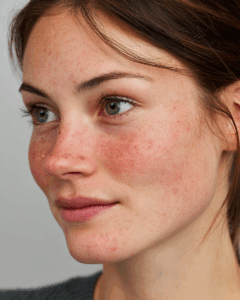Professional Skincare, Skincare
The Benefits of Using Niacinamide in Your Skincare Routine
There’s a certain calm confidence that comes with discovering an ingredient that truly earns its place in your skincare routine. Niacinamide, or vitamin B3, has quietly done just that. It’s not flashy. It doesn’t have the instant-name recognition of retinol or vitamin C. Yet this small, water-soluble vitamin has become a quiet powerhouse – earning loyal fans among dermatologists, estheticians, and everyday skincare enthusiasts. The best part? Niacinamide works beautifully for nearly every skin type.
According to a 2020 study published in The Journal of Clinical and Aesthetic Dermatology, niacinamide helps improve hydration, reduce the appearance of fine lines, even out skin tone, and minimize inflammation – all without the irritation that often accompanies more aggressive actives. That’s a remarkable résumé for one ingredient. Let’s explore why it deserves a permanent spot on your skincare shelf.
What Niacinamide Actually Does
Niacinamide is a form of vitamin B3, an essential nutrient that supports your skin’s ability to function and repair itself. When applied topically, it helps the skin produce ceramides – those natural lipids that keep your barrier strong, supple, and hydrated. A healthy barrier means less moisture loss, fewer dry patches, and less sensitivity overall.
But hydration is just the start. Niacinamide’s influence runs deep. It interacts with multiple cellular pathways, balancing sebum (oil) production, calming redness, brightening dark spots, and supporting collagen production. This versatility makes it a key ingredient whether you’re battling acne, dullness, or early signs of aging.
Think of niacinamide as your skin’s multitasking teammate – it doesn’t overpromise, it just performs. It doesn’t peel, sting, or require recovery time. Instead, it nurtures your skin’s natural systems to work better on their own.

Strengthening the Skin Barrier
If your skin barrier is like a wall, ceramides are the bricks and niacinamide is the foreman overseeing repairs. Every day, pollution, UV rays, and even harsh cleansers can damage this barrier, leading to dehydration, tightness, and increased sensitivity. Niacinamide helps rebuild what’s lost, encouraging the skin to produce more ceramides and fatty acids.
After several weeks of consistent use, skin tends to feel softer, more balanced, and less reactive. This is especially beneficial for those with eczema-prone or sensitive skin, where even small irritations can trigger flare-ups.
Dermatologists often recommend niacinamide as a gentle daily shield – helping the skin bounce back from stress and maintain its resilience against environmental aggressors.
Fading Dark Spots and Brightening Dull Skin
Uneven tone is one of the most stubborn and frustrating concerns. Hyperpigmentation can be caused by sun exposure, acne scars, or hormonal changes, and it rarely fades quickly. Niacinamide helps by interfering with the transfer of pigment (melanin) from the deeper layers of skin to the surface.
In other words, it slows the process that makes dark spots visible. Over time, this leads to a more even, luminous complexion. When paired with ingredients like vitamin C or licorice root extract, niacinamide’s brightening effect is even stronger – without the irritation that hydroquinone-based products can cause.
You won’t see an overnight transformation, but with steady use, most people notice a visible improvement within 8 to 12 weeks. The glow you get looks real – not artificial or masked – because it comes from skin that’s simply functioning at its best.

Controlling Excess Oil and Minimizing Pores
For anyone dealing with oily or combination skin, niacinamide can be a quiet game-changer. By regulating the amount of sebum produced in your pores, it helps reduce shine and congestion without stripping the skin dry.
When oil levels stabilize, pores often appear smaller – not because they’re physically shrinking, but because they’re less clogged and stretched. This makes texture appear smoother and makeup apply more evenly.
Interestingly, niacinamide’s oil-balancing ability can also benefit dry or mature skin types. It supports a natural equilibrium – encouraging enough oil to protect the skin, but not so much that it becomes greasy or acne-prone.
Soothing Redness and Inflammation
If your skin is easily irritated, niacinamide can act as a gentle buffer. It helps calm redness and reduce inflammation, making it especially useful for rosacea, post-acne irritation, or any condition that causes flushing or discomfort.
Part of this soothing ability comes from niacinamide’s impact on the immune response. It helps reduce cytokines – chemical messengers that trigger inflammation. At the same time, it boosts microcirculation and strengthens capillaries, which can help lessen visible redness over time.
The effect is subtle but steady: less heat, less visible blotchiness, and a more even tone overall. Unlike harsher anti-redness treatments, niacinamide accomplishes this quietly – no peeling, no burning, just calm balance.
Supporting Anti-Aging Goals
Fine lines and sagging skin often result from cumulative damage: UV exposure, dehydration, and collagen breakdown. Niacinamide helps address each of these issues simultaneously.
First, it boosts the skin’s production of keratin – a structural protein that keeps the skin firm and smooth. It also supports collagen and elastin synthesis, helping to reduce the look of fine lines. Then, by strengthening the skin barrier, it prevents moisture loss, which keeps the skin plump and hydrated.
Over time, users often report a visible “refreshed” look – skin appears firmer, more resilient, and less fatigued. While niacinamide may not be as potent as retinol in stimulating collagen, it’s far gentler and pairs beautifully with stronger actives to create a balanced routine.

The Perfect Partner Ingredient
Niacinamide plays well with others. It’s one of those rare actives that enhances the performance of nearly everything around it. For instance, pairing niacinamide with hyaluronic acid improves hydration and barrier repair. Combining it with vitamin C or kojic acid enhances brightening effects. And using it alongside retinol can actually help reduce the irritation retinoids sometimes cause.
The only caution is to avoid layering it with strong acids (like pure glycolic or lactic) in the same routine if your skin is easily irritated. Otherwise, niacinamide integrates seamlessly into both morning and evening skincare steps.
How to Add Niacinamide to Your Routine
The most common forms are serums, moisturizers, and creams. Concentrations typically range from 2% to 10%, depending on the formulation. If you’re new to it, start with something around 5% – that’s enough to see benefits without risk of irritation.
Apply it after cleansing and toning, but before heavier moisturizers or oils. In the morning, follow with sunscreen. In the evening, it can be layered under night creams or hydrating masks.
Because niacinamide works gradually, consistency is key. The improvements build week by week: less shine, fewer breakouts, softer texture, brighter tone. It’s one of those ingredients that rewards patience – steady use transforms the overall look and feel of your skin.
What to Expect When You Start
Niacinamide is well-tolerated by nearly everyone, but every skin is unique. Occasionally, if you use too high a concentration too soon, you may experience mild redness or tingling. This typically subsides quickly and can be minimized by using a lower-strength product or alternating days until your skin adjusts.
Most users notice subtle hydration improvements within a week or two. Oil control and redness reduction may appear within a month. Brightening and firming changes typically take eight to twelve weeks to become clear. The slow, steady results are part of niacinamide’s charm – it doesn’t shock your skin; it teaches it to thrive.
Why Professionals Love It
Ask any esthetician about their favorite multitasking ingredient, and niacinamide almost always makes the shortlist. It works for acne-prone teens, stressed-out adults, and mature skin alike. That universality makes it an indispensable tool for both professional treatments and home care.
Its non-irritating nature also means it can be used year-round, even in combination with other treatments like chemical peels or exfoliating acids. Professionals often incorporate niacinamide serums post-extraction or post-peel to calm inflammation and accelerate recovery.
Because it helps restore balance rather than mask symptoms, niacinamide tends to improve skin’s long-term behavior – less overproduction of oil, fewer flare-ups, and stronger resilience overall.
Environmental Protection from Within
Modern living exposes our skin to countless forms of stress: pollution, blue light, UV rays, and temperature changes. Niacinamide helps defend against oxidative stress by neutralizing free radicals – unstable molecules that damage DNA and accelerate aging.
This antioxidant action, combined with its barrier-repair properties, means niacinamide functions as a daily “shield.” Used in the morning before sunscreen, it reinforces your skin’s natural defense line. At night, it helps your skin recover from the environmental assaults of the day.
If you live in a city, spend hours in front of screens, or simply want to slow the visible signs of aging, this layer of protection makes a measurable difference.
Addressing Acne and Blemishes
Niacinamide has another remarkable strength: it helps reduce breakouts without drying the skin. By normalizing oil production and calming inflammation, it minimizes the conditions that lead to clogged pores and acne flare-ups.
Research has shown that a 4% niacinamide gel can be as effective as 1% clindamycin (a common topical antibiotic) in reducing acne lesions – without contributing to antibiotic resistance. That makes it an excellent long-term option for managing mild to moderate acne.
Additionally, niacinamide helps fade the marks that acne leaves behind. It doesn’t just clear active blemishes – it helps your skin look clearer overall by evening tone and texture once inflammation has resolved.
Choosing the Right Niacinamide Product
When selecting a niacinamide product, focus on formulation quality. Look for products that clearly state the percentage (ideally 5% or less for beginners). Avoid formulas overloaded with alcohol or fragrance, as they can counteract niacinamide’s calming benefits.
For hydration and barrier support, look for a niacinamide serum combined with hyaluronic acid or panthenol. For oil control, a lightweight gel or emulsion works well. And if you’re addressing dark spots, choose products that pair niacinamide with brighteners like arbutin, licorice extract, or stabilized vitamin C.
The packaging matters too. Niacinamide degrades with excessive air or light exposure, so opaque, air-tight containers are best.
My Own Experience with Niacinamide
The first time I tried a niacinamide serum, I expected very little. It seemed too “basic.” But within a few weeks, something subtle changed – my skin looked steadier. Breakouts were less frequent, redness less dramatic, texture smoother. It didn’t transform my face overnight; it just brought back a sense of normalcy and health.
That’s why I love recommending it. Niacinamide isn’t about chasing trends; it’s about restoring what your skin already knows how to do. It’s quiet care – smart, simple, and profoundly effective.
Frequently Asked Questions
Is niacinamide safe to use every day?
Yes. Niacinamide is gentle enough for daily use, morning and night. Its low irritation potential makes it suitable even for sensitive or rosacea-prone skin.
Can niacinamide be used with retinol?
Absolutely. In fact, niacinamide can help buffer potential dryness or irritation from retinol, allowing you to enjoy both anti-aging and calming benefits simultaneously.
How long before I see results?
Some users notice improved hydration within a week, while brightness and even tone typically develop after two to three months of consistent use.
Can I use niacinamide with vitamin C?
Yes. Modern formulations are stable enough to pair them safely. The combination can amplify brightening and antioxidant protection.
What percentage of niacinamide is most effective?
Studies suggest that 2–5% provides excellent benefits for most people. Higher concentrations (10% or more) can be effective but may cause temporary flushing in sensitive skin.
Why Niacinamide Deserves Its Spotlight
Skincare often celebrates extremes – powerful acids, high-strength retinoids, or rare botanical extracts. Niacinamide doesn’t compete on hype. It earns loyalty because it works quietly across multiple fronts. It strengthens, hydrates, calms, and brightens. It’s compatible with nearly every other ingredient and kind to nearly every skin type.
At its best, skincare should make your skin function better – not force it into short-term reactions. Niacinamide embodies that philosophy. It’s the ingredient that helps your skin help itself.
So if you’re seeking a simple way to bring balance back – to hydrate without heaviness, to brighten without sting, to smooth without peeling – start here. A few drops of niacinamide might just be the most unassuming yet transformative step in your daily routine.





